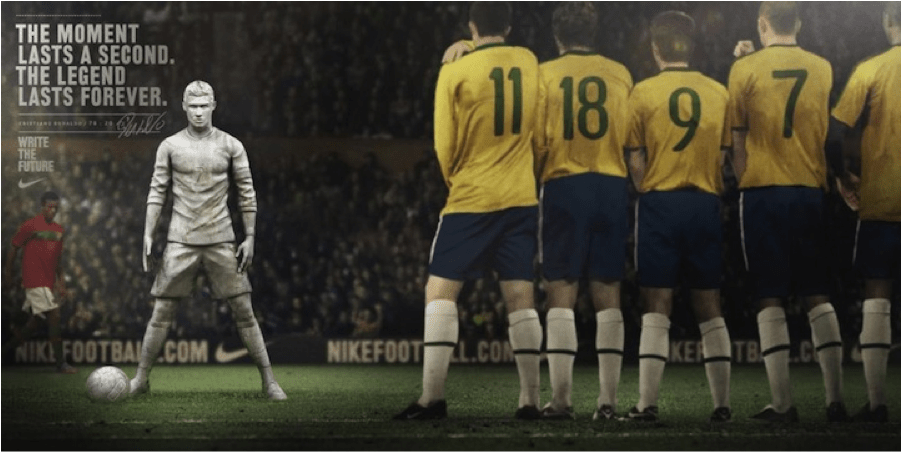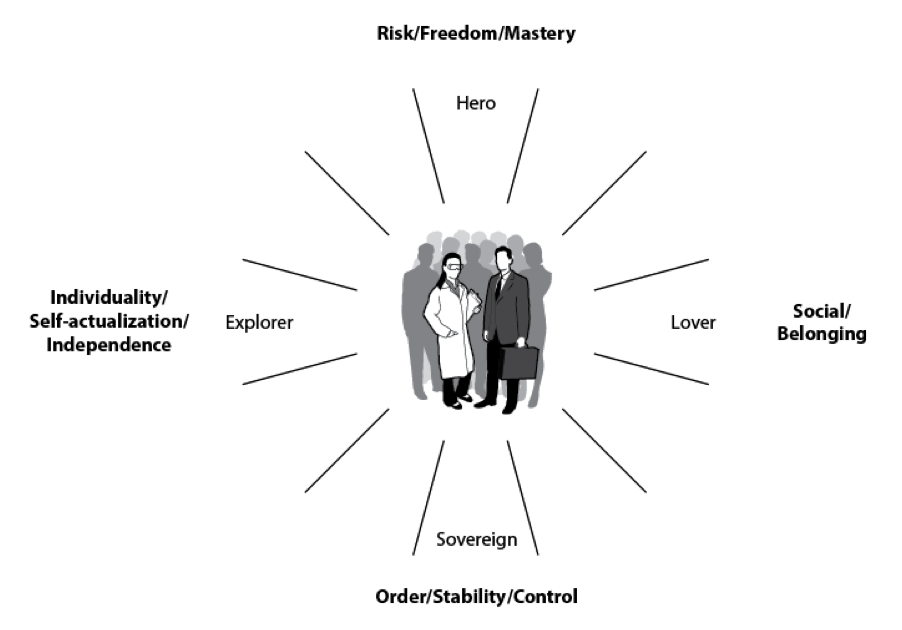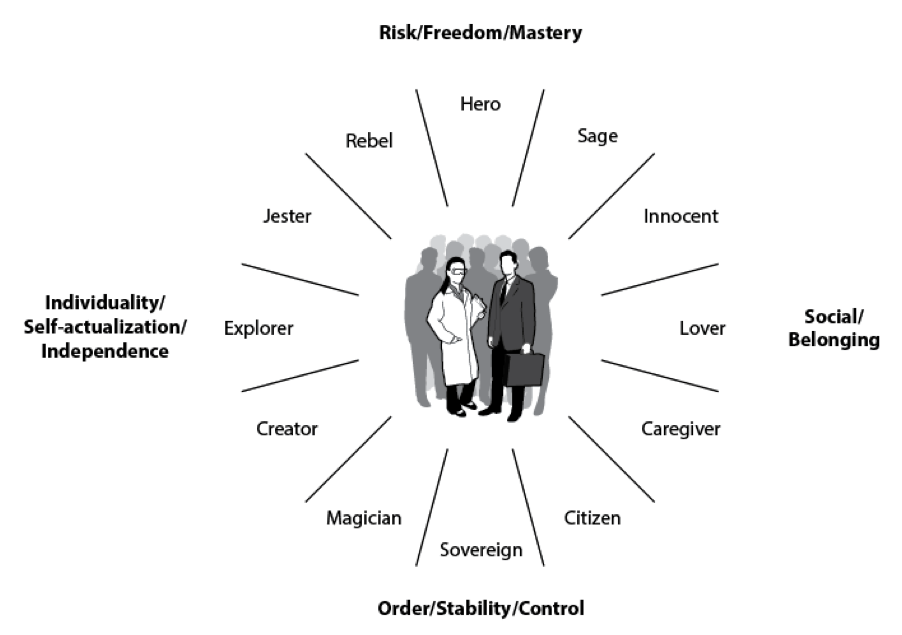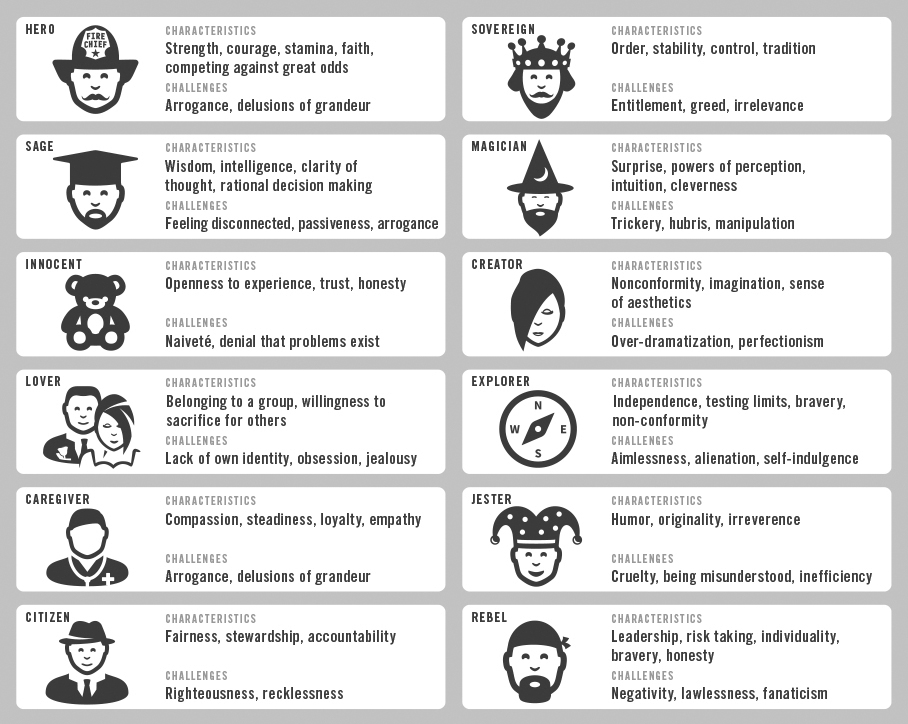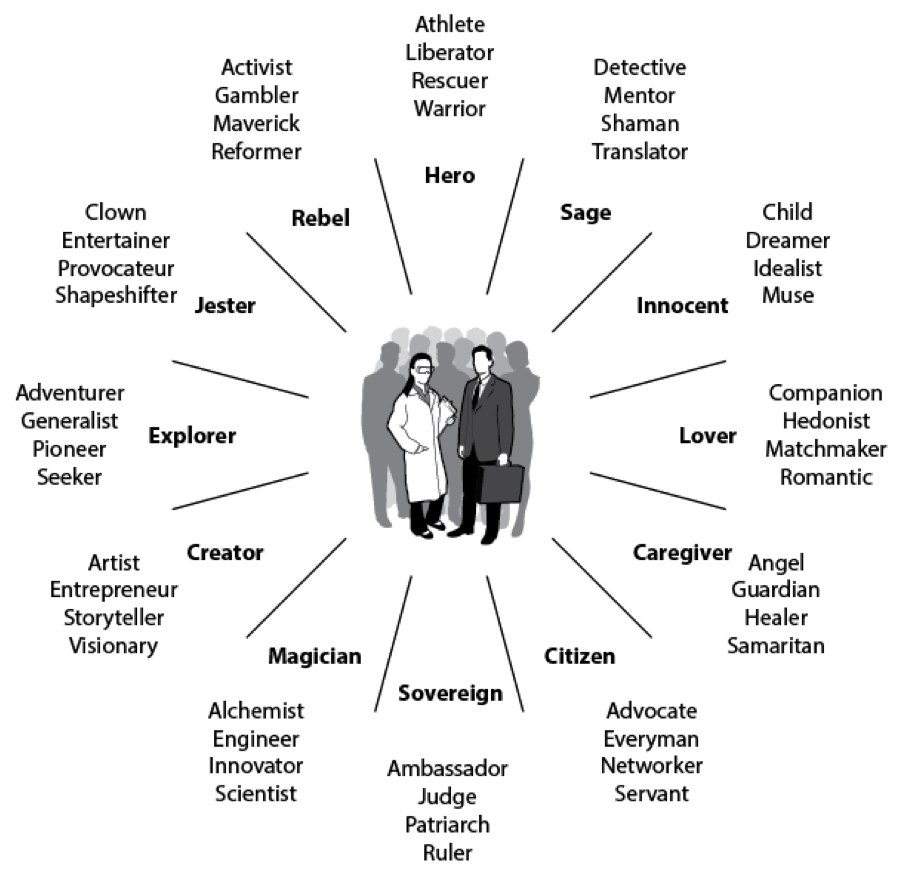Families of archetypes and their use in life science marketing
By David Chapin
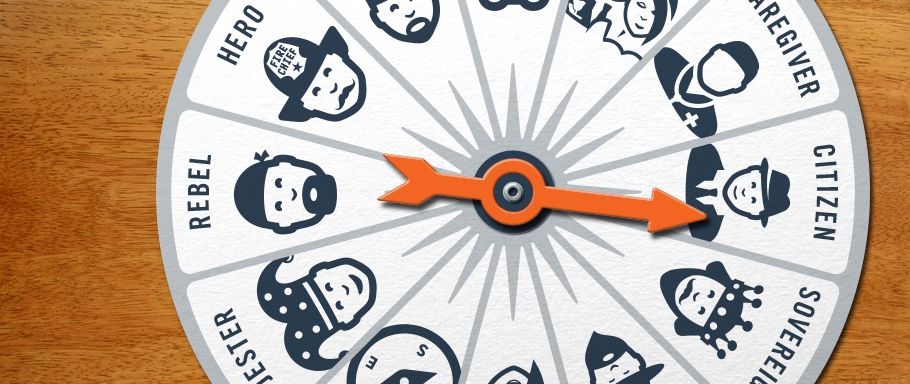
SUMMARY
VOLUME 6
, NUMER 3
Summary: Archetypes are a powerful tool to guide the development of your marketing communications. In this issue, we’ll start by examining one of the sources of the strength of archetypes: pattern matching. We’ll look at the twelve families of archetypes and at the many different archetypes within these families. And we’ll discuss why you shouldn’t select the Scientist or the Innovator as your archetype.
Archetypes and meaning in life science marketing
In our last issue we introduced the use of archetypes in life science marketing. Archetypes are a collectively inherited unconscious idea, pattern, or image that is universally present in individual psyches. In other words, a character or “type” we all intuitively understand.
The value of archetypes springs from how quickly they can be recognized and how easily an audience can complete the picture. When shown part of the pattern (the Ruler, or the Jester, for example), the audience tends to automatically fill in the rest and to assign meaning to the completed pattern. This allows archetypes to be used as an emotional and meaningful “shorthand,” one that can assist in creating connections with your audience.
Archetypes are one effective way to manage the meaning of your brand-story in life science marketing. This can lead to greater differentiation and therefore to increased pricing power. In this issue, we’ll look at many different archetypes, and explore their use more fully.
Completing the pattern
What are the attributes of a hero? Stories of heroes abound throughout all cultures, from Odysseus to Harry Potter. Heroes exhibit strength, courage, stamina, commitment, and faith. Heroes often sacrifice, for themselves and for others. They are willing to take great risks.
This combination of attributes creates a pattern that people recognize. Why do we recognize these kinds of patterns? One could argue that we are taught these patterns by our cultures. Or one could argue, as Carl Jung does, that these patterns are universal and unconscious. The source of the pattern is not central to this discussion; what is important is what we mentioned above: audiences recognize these patterns, and in fact will complete a pattern even if they are only shown part of it. For example, if you were shown evidence of a character in a story exhibiting strength, courage, stamina, commitment, and faith, in which of the following two situations would you expect to find this character:
a) Relaxing, having a good time with friends and focusing on relationships, or
b) Competing against great odds?
If you’re like most people, you’d pick b) as the likely choice. Competing against great odds is part of the Hero pattern – the archetype. It’s what we expect heroes to do. Again, if we are shown part of the Hero pattern, we will complete it all by ourselves, without being shown the rest of the pattern.
Pattern matching is very strong in humans. In fact, it’s so strong that there’s a word for the tendency to complete patterns and to find meaning even where no meaning exists. Apophenia refers to the general condition of finding meaning and patterns in all types of stimulus, and Pareidolia refers to the specific case of visual pattern matching. These are not some rare conditions. Everyone exhibits these from time to time. Classic examples range from seeing the man in the moon, to finding meaning in a Rorschach ink blot, to seeing the face of Jesus in a grilled cheese sandwich.
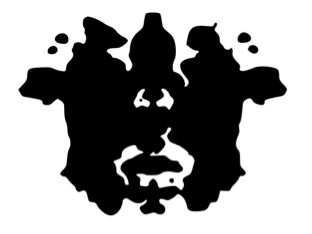
Figure 1: Seeing meaning is a common and powerful human tendency. It’s so common that it occurs even where no meaning exists, like in the inkblot shown here. The use of archetypes allows us to tap this tendency in life science marketing.
This natural human tendency to complete patterns and to find meaning from incomplete patterns is what gives archetypes their power.
Archetypes and pattern matching in life science marketing
How are archetypes and pattern matching useful in marketing? If you remember the Marketing Mechanism of Action (Vol 5, Issue 7), you’ll recall that marketing works by encouraging audiences to embed a particular “image” or meaning in their minds. We want to encourage the audience to associate our organization with a particular image or meaning. For example, Volvo® seems to want their audience to associate their product with safety; Walmart® seems to want an association with low prices.
If your organization can identify an appropriate archetype, and if you have the skill to do so, you can use an archetype to connect with your audience members and help them associate a particular set of meanings with your brand. If you (that is, your organization, your products or your services) exhibit characteristics typical of a particular archetype, your audiences will expect certain behaviors from you – and further, they will assign additional character traits to you. Archetypes help build images in your audience members’ minds.
An example of archetypes in marketing
Let’s look at a well-known retail example. The athletic equipment company Nike® embodies the Hero archetype. Why has Nike chosen this archetype? Because the traits associated with its pattern (specifically: strength, courage, stamina, faith, the willingness to take great risks and compete against great odds) fit well with the idea of athletic competition. As an example of the Hero archetype in action, we need look no further than this advertisement from Nike.
The headline reads: The moment lasts a second. The legend lasts forever. This football (soccer) player and the penalty kick he’s about to take are so important that he’s been immortalized in stone.
Who do we make statues of? Our heroes. The archetype could not be more clear. Go to a search engine and look for images of Nike advertisements. You’ll see the Hero everywhere.
When the reader sees the hero soccer player, they see someone strong who is competing against great odds. (After all, there are at least five opposing players lined up against him.) Strength and competing against great odds are parts of an archetypal pattern, and so the reader unconsciously tends to complete the rest of the pattern: stamina, determination, courage, willingness to take great risks, etc.
When audiences complete the archetypal pattern for you, you’ve just engaged them to do some of your work as a marketer. You’re using a meaning-full “shorthand” – you provide part of the pattern, and your audiences fills in the rest. This is incredibly valuable, in part because of our audiences’ limited attention span. Getting them to pay attention is hard enough, but getting them to pay attention while you recite a long, complex set of brand characteristics is almost impossible. By using archetypes, you can condense your communications, knowing that the audience will “unpack” it and complete it for you.
The use of archetypes has many other benefits. I’ve found that when our clients use archetypes, they tend to have more consistent communications; they stay “on brand and on message” more consistently. Given the fact that consistency across the ladder of lead generation is so important, this benefit cannot be overemphasized.
How the use of archetypes can damage your life science marketing.
The use of archetypes is powerful, but if archetypes are used inappropriately or clumsily, you can cause significant harm to your organization’s image. Each archetype has particular failings, and your audience understands these failings as part of the archetypal pattern.
For example, the Hero can be prone to arrogance or to delusions of grandeur. Think of Icarus, who flew too close to the sun. This is an example of one of the negative characteristics of the Hero archetype.
These negative characteristics cannot be left behind. With the positive parts of any archetype, you also bring the negative, and it is these potential negatives that make archetypes potentially dangerous.
While there are many benefits of archetypes, their misuse can do significant damage, so please be careful. Unfortunately, there are no simple rules for avoiding the negative consequences of the use of a particular archetype. You must be aware of the negative tendencies for each archetype and use skill and experience in applying archetypal characteristics to your brand, organization, products or services.
Different types of archetypes in life science marketing
There are hundreds of archetypes, maybe even thousands. The final number is not really important. It is important to recognize that archetypes can be divided into positive and negative types. Negative archetypes, such as the Bully or the Evil Dictator are not typically used in marketing, so I won’t explore them here. But it is important to realize that they exist. Some of these negative archetypes are closely related to positive ones. As I’ve pointed out about the Hero, every archetype has inherent in it one or more potential character flaws – flaws that can bring out the negative characteristics of the archetype.
If we consider the positive archetypes, there are many ways to classify them. I’ll use a system in which archetypes can be plotted on two axes, based in part on the work done by Margaret Mark and Carol S. Pearson and published in The Hero and the Outlaw in 2001. On the horizontal axis, the need for social belonging is placed at one end of the spectrum and the need for independence at the other end. Similarly, order, stability and control are shown at the bottom end of the vertical spectrum, while risk, freedom and mastery are depicted at the top. Using these spectra, we can plot four basic archetypes: the Hero represents risk, freedom and mastery, and the Sovereign represents order, stability and control. The Lover represents community and belonging, and the Explorer represents independence and self-actualization.
The twelve families
Each of the twelve families has particular characteristics. Some of these characteristics are shared strongly by all the members of this family; some characteristics are only shared in a more casual way.
You must understand these characteristics if you are going to use archetypes effectively. You must also understand that these characteristics are more extensive and run much deeper than the short list I’m providing here.
Each of the individual archetypes in a particular family is related in some way to the other members of their family. There are differences, however, and these differences can be significant when using archetypes for managing the meaning of your organization, products or services. For example, both the Scientist and the Magician are part of the same family, and one of the attributes they share is a fascination about the workings of the universe. There are differences however: the Magician dreams great dreams and translates these into reality, sometimes using methods that may seem mysterious, whereas the Scientist is more grounded and displays greater tenacity. The Magician is more charismatic; the Scientist more logical.
These differences would guide both the selection of the individual archetype as well as its use.
Why you shouldn’t choose the Scientist or the Innovator archetypes.
The Scientist and the Innovator are part of the Magician family. Many life science companies default to the Scientist or the Innovator archetype in their life science marketing and communications. They haven’t chosen an archetype deliberately, but their language and messages embody this archetype naturally.
These archetypes have significant strengths. For example, the positive aspects of the Scientist include a desire to take things apart. This archetype is driven by a need to understand Nature’s deepest secrets and the theory behind these mysteries. The potential downsides of the Scientist include the tendency to focus on the details and miss the big picture. (more here) This can manifest itself in the inability to recognize a vital deficit or flaw.
While the Scientist and the Innovator have characteristics that are valued by life science audiences, the fact that many companies exhibit these archetypes in their marketing communications means that choosing either one of these as your archetype will in all likelihood be non-differentiating. Since one of the primary benefits of archetypes is to differentiate your offering, you should only choose the Scientist or the Innovator after careful examination of all your life science competitor’s marketing activities and then only with a thorough understanding of the fact that your choice will make the task of differentiating your offering very, very difficult.
Conclusion
Using archetypes is not a casual pursuit. You can gain great benefit, but you must understand the power of archetypes in general and the strengths of the particular archetype you choose, as well as the potential weaknesses.
As I pointed out in the last issue, research has shown that companies that varied their archetype over time were less profitable than those that stuck with one particular archetype. So you must not treat archetypes as the fad of the month, applying archetypes when it suits and ignoring them the rest of the time – doing so may harm your brand.
Part of the power of archetypes comes from the internal consistency their use brings. But this consistency only comes about from careful thought, good execution and a very steady hand.
In our next issue, I’ll discuss the different uses of archetypes, the various places you can employ them, and I’ll give you specific examples of how archetypes can be used to guide even the smallest details of your marketing and communications with your life science audiences.
The Marketing of Science is published by Forma Life Science Marketing approximately ten times per year. To subscribe to this free publication, email us at info@formalifesciencemarketing.com.
David Chapin is author of the book “The Marketing of Science: Making the Complex Compelling,” available now from Rockbench Press and on Amazon. He was named Best Consultant in the inaugural 2013 BDO Triangle Life Science Awards. David serves on the board of NCBio.
David has a Bachelor’s degree in Physics from Swarthmore College and a Master’s degree in Design from NC State University. He is the named inventor on more than forty patents in the US and abroad. His work has been recognized by AIGA, and featured in publications such as the Harvard Business Review, ID magazine, Print magazine, Design News magazine and Medical Marketing and Media. David has authored articles published by Life Science Leader, Impact, and PharmaExec magazines and MedAd News. He has taught at the Kenan-Flagler Business School at UNC-Chapel Hill and at the College of Design at NC State University. He has lectured and presented to numerous groups about various topics in marketing.
Forma Life Science Marketing is a leading marketing firm for life science, companies. Forma works with life science organizations to increase marketing effectiveness and drive revenue, differentiate organizations, focus their messages and align their employee teams. Forma distills and communicates complex messages into compelling communications; we make the complex compelling.
© 2024 Forma Life Science Marketing, Inc. All rights reserved. No part of this document may be reproduced or transmitted without obtaining written permission from Forma Life Science Marketing.
